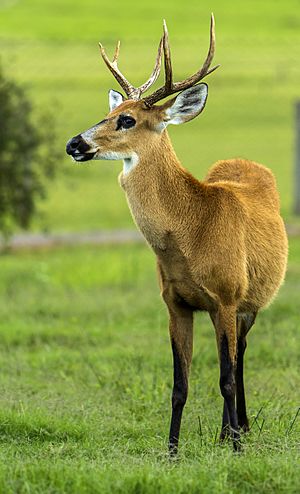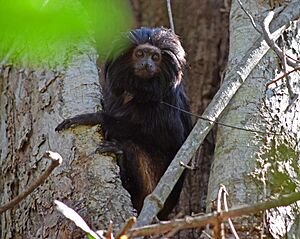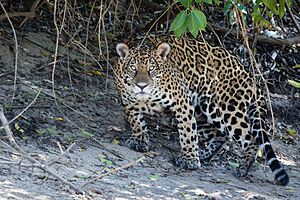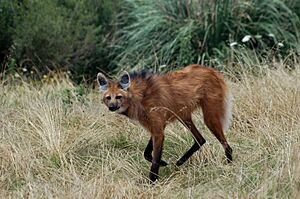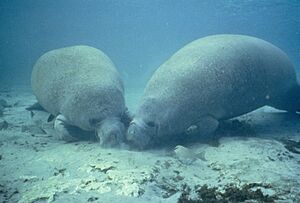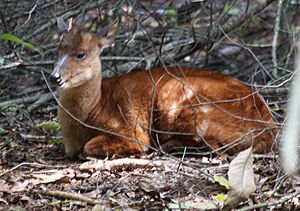List of threatened mammals of Brazil facts for kids
Brazil is home to over 700 different kinds of mammals! But sadly, about 110 of these amazing creatures are in danger of disappearing forever. One species is already extinct, meaning it's gone from the world. These numbers come from the Chico Mendes Institute for Biodiversity Conservation (ICMBio) and Brazil's Ministry of the Environment.
When we say a species is "threatened," it means it's at risk of becoming extinct. Brazil uses the same rules as a big international group called IUCN (International Union for Conservation of Nature) to decide which animals are threatened.
Mammals are grouped into different families, like how your family has a last name. In Brazil, there are 12 main groups (called "orders") of mammals. Almost all of these groups have species that are in danger. For example, rodents are the most diverse group of mammals, but the group with the most threatened species is the Primates (monkeys and their relatives), with 34 species at risk.
A list of these threatened species was officially published in Brazil in 2014. Even though some animals, like the humpback whale, were taken off the list, the total number of threatened species actually went up! Animals like the Brazilian tapir, the white-lipped peccary, and the short-eared dog were added. Sometimes, an animal might be threatened in one part of Brazil but not everywhere.
It's interesting that the ICMBio list and the IUCN list can sometimes be different, even though they use the same rules. This happens because different scientists do their research at different times. Most of Brazil's threatened mammals are considered "vulnerable," which means they are at high risk. One species, Vespucci's rodent, is now extinct. Two others, the black-shouldered opossum and the candango mouse, are "probably extinct" in Brazil.
Contents
- Threatened Mammals of Brazil (2014)
- Opossums (Didelphimorphia)
- Anteaters and Sloths (Pilosa)
- Armadillos (Cingulata)
- Bats (Chiroptera)
- Monkeys, Marmosets, and Tamarins (Primates)
- Cats, Dogs, and Relatives (Carnivora)
- Whales and Dolphins (Cetacea)
- Manatees (Sirenia)
- Odd-toed Ungulates (Perissodactyla)
- Even-toed Ungulates (Artiodactyla)
- Rodents (Rodentia)
- See also
Threatened Mammals of Brazil (2014)
Opossums (Didelphimorphia)
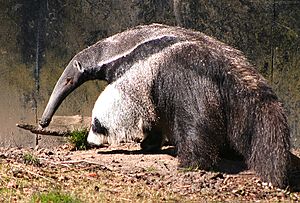
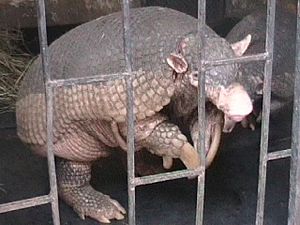
Opossums are small to medium-sized marsupials, meaning they carry their babies in a pouch. Some opossums in Brazil are facing big challenges.
- Caluromysiops irrupta (black-shouldered opossum) - This one is probably extinct in Brazil.
- Marmosops paulensis (Brazilian slender opossum)
- Thylamys macrurus (Paraguayan fat-tailed mouse opossum)
- Thylamys velutinus (dwarf fat-tailed mouse opossum)
Anteaters and Sloths (Pilosa)
This group includes some unique animals known for their slow movements or long tongues.
Three-toed Sloths (Bradypodidae)
- Bradypus torquatus (maned sloth) - This sloth has a special mane of fur around its neck.
Anteaters (Myrmecophagidae)
- Myrmecophaga tridactyla (giant anteater) - The giant anteater is a very unique animal with a long snout and tongue for eating ants and termites.
Armadillos (Cingulata)
Armadillos are known for their tough, bony shells.
- Priodontes maximus (giant armadillo) - This is the largest armadillo species.
- Tolypeutes tricinctus (Brazilian three-banded armadillo) - This armadillo can roll itself into a perfect ball for protection.
Bats (Chiroptera)
Bats are the only mammals that can truly fly. Many bat species are important for pollinating plants and controlling insects.
Smoky Bats (Furipteridae)
- Furipterus horrens (thumbless bat)
Funnel-eared Bats (Natalidae)
- Natalus macrourus (Brazilian funnel-eared bat)
New World Leaf-nosed Bats (Phyllostomidae)
- Glyphonycteris behnii (Behn's bat)
- Lonchophylla aurita
- Lonchophylla dekeyseri (Dekeyser's nectar bat)
- Xeronycteris vieirai (Vieira's long-tongued bat)
Vesper Bats (Vespertilionidae)
- Eptesicus taddeii
Monkeys, Marmosets, and Tamarins (Primates)
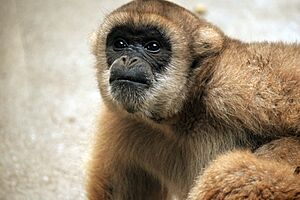

Brazil is home to many different kinds of monkeys, and sadly, many of them are threatened.
Howlers, Spider and Woolly Monkeys, Muriquis (Atelidae)
- Alouatta belzebul (red-handed howler)
- Alouatta discolor (Spix's red-handed howler)
- Brachyteles arachnoides (southern muriqui) - This is one of the largest monkeys in the Americas.
- Brachyteles hypoxanthus (northern muriqui)
Tamarins and Marmosets (Callitrichidae)
- Callithrix aurita (buffy-tufted marmoset)
- Leontopithecus caissara (Superagui lion tamarin)
- Leontopithecus chrysomelas (golden-headed lion tamarin)
- Leontopithecus chrysopygus (black lion tamarin) - This beautiful monkey is endangered.
- Leontopithecus rosalia (golden lion tamarin)
Capuchins and Squirrel Monkeys (Cebidae)
- Cebus kaapori (Kaapori capuchin)
- Sapajus xanthosternos (golden-bellied capuchin) - This capuchin monkey is critically endangered.
Titis, Saki Monkeys, and Uakaris (Pitheciidae)
- Cacajao hosomi (Neblina uakari)
- Chiropotes satanas (black bearded saki)
Cats, Dogs, and Relatives (Carnivora)
This group includes some of Brazil's most famous predators.
Dogs (Canidae)
- Atelocynus microtis (short-eared dog)
- Chrysocyon brachyurus (maned wolf) - This tall, fox-like animal is a unique South American canid.
- Speothos venaticus (bush dog)
Otters (Mustelidae)
- Pteronura brasiliensis (giant otter) - These large, social otters live in rivers.
Cats (Felidae)
- Leopardus colocolo (colocolo)
- Leopardus guttulus (southern tigrina)
- Panthera onca (jaguar) - The jaguar is the largest cat in the Americas.
Whales and Dolphins (Cetacea)

Many marine mammals that visit or live in Brazilian waters are also at risk.
Whales (Balaenidae)
- Eubalaena australis (southern right whale) - These large whales are known for their distinctive callosities (rough patches of skin).
Rorquals (Balaenopteridae)
- Balaenoptera musculus (blue whale) - The blue whale is the largest animal on Earth.
- Balaenoptera physalus (fin whale)
Dolphins (Delphinidae)
- Sotalia guianensis (Guiana dolphin)
River Dolphins (Iniidae)
- Inia geoffrensis (Amazon river dolphin) - These unique dolphins live in freshwater rivers.
River Dolphins (Pontoporiidae)
- Pontoporia blainvillei (La Plata dolphin)
Manatees (Sirenia)
Manatees are gentle, slow-moving marine mammals.
- Trichechus inunguis (Amazonian manatee)
- Trichechus manatus (West Indian manatee) - This manatee is critically endangered in Brazil.
Odd-toed Ungulates (Perissodactyla)
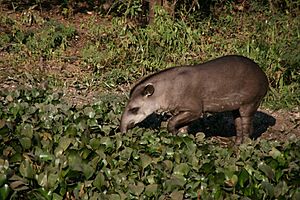
This group includes animals with an odd number of toes on each foot.
Tapirs (Tapiridae)
- Tapirus terrestris (Brazilian tapir) - The Brazilian tapir is the largest land mammal in South America.
Even-toed Ungulates (Artiodactyla)
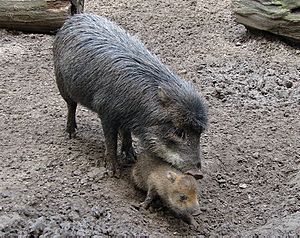
These animals have an even number of toes.
Deer (Cervidae)
- Blastocerus dichotomus (marsh deer) - This is the largest deer in South America.
- Mazama nana (pygmy brocket) - A very small deer from southern Brazil.
- Ozotoceros bezoarticus bezoarticus (Pampas deer)
Peccaries (Tayassuidae)
- Tayassu pecari (white-lipped peccary) - These wild pigs live in large groups.
Rodents (Rodentia)

Rodents are a very diverse group, including mice, rats, and cavies.
Cavies (Caviidae)
- Cavia intermedia (Santa Catarina's guinea pig)
- Kerodon rupestris (rock cavy) - This cavy lives among rocks.
New World Rats and Mice (Cricetidae)
- Juscelinomys candango (candango mouse) - This mouse is probably extinct in Brazil.
- Noronhomys vespuccii (Vespucci's rodent) - This rodent is now extinct.
Tuco-tucos (Ctenomyidae)
- Ctenomys flamarioni (Flamarion's tuco-tuco)
Echimyidae
- Callistomys pictus (painted tree-rat)
- Phyllomys thomasi (giant Atlantic tree-rat)
New World Porcupine (Erethizontidae)
- Chaetomys subspinosus (bristle-spined rat)
See also
- List of mammals of Brazil


